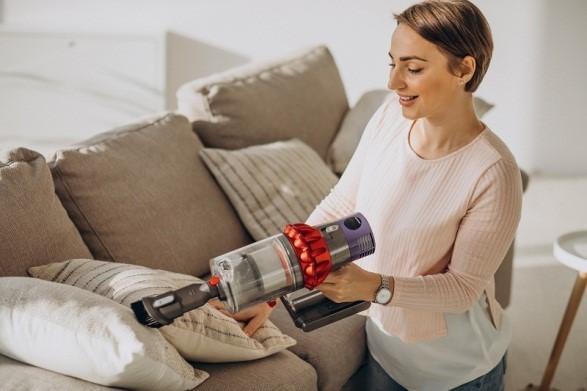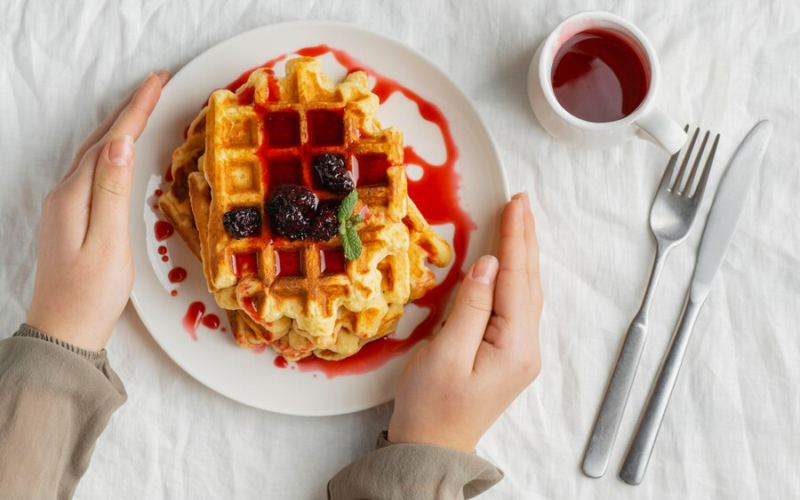
Upholstered furniture and sofas are as beautiful as they are demanding. Both textile fibres and materials such as leather and eco-friendly leather can be easily dyed and become a suitable environment for dust and mites. They can also get an unusual and unpleasant smell in time. Luckily, there are now more solutions than ever for all of these problems. Find out what tricks can help you freshen up the smell of your sofa and make your upholstered furniture look new.
- Types of fabrics for furniture and restrictions on their cleaning
- Tips for removing various types of upholstery stains
- Tips for regular cleaning and care of your sofa and upholstery
- Ways to protect upholstery and sofas from textile material
Types of Fabrics for Furniture and Restrictions on Their Cleaning
Upholstery materials are varied and some need special handling when it comes to cleaning and maintenance. Each of them has its characteristics and quirks when it comes to cleaning solutions and methods. In order not to suffer from cleaning, you can upholster the sofa with another fabric and your sofa will be like new, read more about furniture upholstery click here.
- For example, velvet can get dirty if cleaned on-site, especially if it’s an old sofa or piece of furniture that has been infiltrated with dust. The material cleans up easily with solutions specially formulated for textiles, but when cleaned topically to remove stains, it can take on a different shade, fresher and lighter than the rest of the batches, blends easily after use.
- Woollen and woollen fabrics should not be cleaned with hot water in any form, even when the upholstery is removable, because the material can get into the water, shrinking.
- Microfiber is less demanding and dries very easily.
- In the case of other textile materials, cleaning methods may vary depending on the colour and fibres, and as a rule, the technical data can be found on the label.
- Eco-leather, in turn, is easy to care for and does not leave stains, unlike genuine leather, it is more permeable and more sensitive even to contact with water. However, it is sensitive to high temperatures, as well as to synthetic textile materials, as well as to alcohol-based solvents.
Tips for Removing Various Types of Upholstery Stains
Grease stain cleaning techniques and solutions are different from those used to remove wine or blood stains from furniture or sofa upholstery. Therefore, some tricks in this regard will be more than useful to you:
Grease Spots
For oil stains, oil, natural fat, various body creams or lotions, you will need a degreaser. To remove fresh grease stains, sprinkle on baking soda and wait for it to absorb excess grease; Then inhale the baking powder and clean the surface with a solution of water and dishwasher detergent.
Sweat Stains
To remove sweat stains from sofas, it is enough to wipe the material with a sponge, a solution of vinegar and water, in proportion to ⅓. Vinegar will freshen up the colours and give them uniformity, neutralizing unpleasant odours.
Pen or Ink Stains
Pen stains can be removed from fabrics using alcohol-based products that act as solvents for this type of stain. Another method for removing paste from textile materials is a hair fixative; it is sprayed onto the stain, allowed to dry, and then removed with a special upholstery cleaner.
For ink stains, it is important to immediately absorb the excess with a paper towel. To remove them, you can lightly tamp the area, alternatively with a woollen floppy disk soaked in alcohol and cold water.
Mould Spots
Excessive humidity in a home can lead to mould and, indirectly, mould stains. They can be removed with a paste of baking soda and water – a paste that you then leave to dry and then aspirate. No less effective is also oxygenated water-diluted 1/10 of the proportion of water, as well as a paste obtained from lemon juice and a teaspoon of salt.
Other Common Upholstery Stains
Juice Stains: These types of stains are removed with a solution of vinegar and ammonia; The paste obtained from the two ingredients is applied locally and dried, after which the surface is cleaned with a dry cotton cloth.
Red Wine Stains: Can be removed with white vinegar or a solution of vinegar and bicarbonate.
Blood Stains: On upholstery can be removed with a solution based on water, salt or ammonia. Use cold water because blood is made of protein and stains can become even more visible after heat treatment.
Coffee Stains: Disappear with mineral water; Soak a cotton swab in sparkling water and gently pat the area until the stain disappears. You can also use undiluted vinegar.
Wax: Can be removed from fabrics, but the process is more difficult than with other stains. First of all, it must be completely dried and cured before cleaning. If it is more wax, you may scratch the surface layer with a knife, but be careful not to cut the material. Apply a piece of parchment paper or kitchen towels over the stain, turn on the iron at a temperature high enough to melt the wax without damaging the material, and gently press down on the paper until the wax is transferred to it; Repeat the process by changing the position of the paper until the fabric is clean.
Chewing Gum: Can be removed with paper and iron, like wax. Other methods are freezing the material or boiling it in water, but these can only be used for removable upholstery and covers for sofas or other furniture.
Industrial Upholstery Cleaning Solutions
Detergents and vinegar-based solutions can help remove certain stains, but professional solutions and chemical cleaning are often faster and safer.
If it’s removable upholstery or a sofa cover, you can use a cleaner to remove stains and update colours.
There are many products in the trade specifically designed for certain types of fabrics; You can find them in furniture stores and also in auto shops where they are sold for car upholstery cleaning.
Tips for Regular Cleaning and Care of Your Sofa and Upholstery
In addition to stains caused by accidents, upholstered sofas and furniture need regular cleaning and maintenance. From dust and pet hair removal to refreshing colours and scents, upholstery will constantly demand your attention and effort.
Removing Bad Odours
Smells of food, cigarette smoke, or odours from an unventilated space can be saturated with fabrics and upholstery. They can be removed with solutions based on vinegar, baking soda, or lemon juice, as well as solutions specially formulated for cleaning fabrics. To prevent these odours, keep your home well ventilated and use a dehumidifier if the humidity in your home is high.
Removing Dust and Hair Left by Pets
The vacuum cleaner is holy when it comes to cleaning dust and hair left behind by animals. You can also use a lint remover or a brush specifically designed for cleaning textiles from your hair.
Refresh Fabric
Upholstery colour may soften over time, but vinegar solutions in water (⅓) can work wonders to freshen them up. In addition, solutions designed for cleaning carpets can also be useful for textile upholstery and sofas.
Removing Insects from the Sofa
Linen is a common problem for sofas and upholstery. These fish are both humans and pets and cause skin irritation, but can also promote disease transmission.
In extreme cases, it is recommended to dispose of infested objects, but when locusts are found shortly after the incident, you can try to save the upholstery. High temperatures can break them down, so a steam cleaner can be very effective at removing them.
You should know that these insects are very sensitive to strong odours, so they can be removed with brownies or cinnamon sticks. Additionally, vinegar-water solutions can also be effective in this regard. If you are unable to remove them, call the pesticide company.
Ways to Protect Upholstery and Sofas from Textile Material
One way to protect textile upholstery is to use permanent covers. They can be purchased from interior design stores or can be custom made for furniture that doesn’t come in standard sizes. They are removable and you can wash them by hand, in the washing machine or when cleaning, and they will effectively protect the upholstery, especially if the material from which they are made is impervious or has an impervious lining.
Textile materials may discolour if left in the sun for a long time. Therefore, it is advisable not to place them near windows or outside. To refresh the colours, you can use one of the tricks mentioned above, but they won’t work if the UV exposure is constant.
During periods when they are not in use, such as when you are on vacation, textile upholstery can be protected from dust with covers or just blankets.





